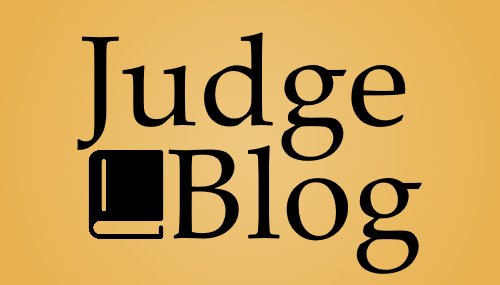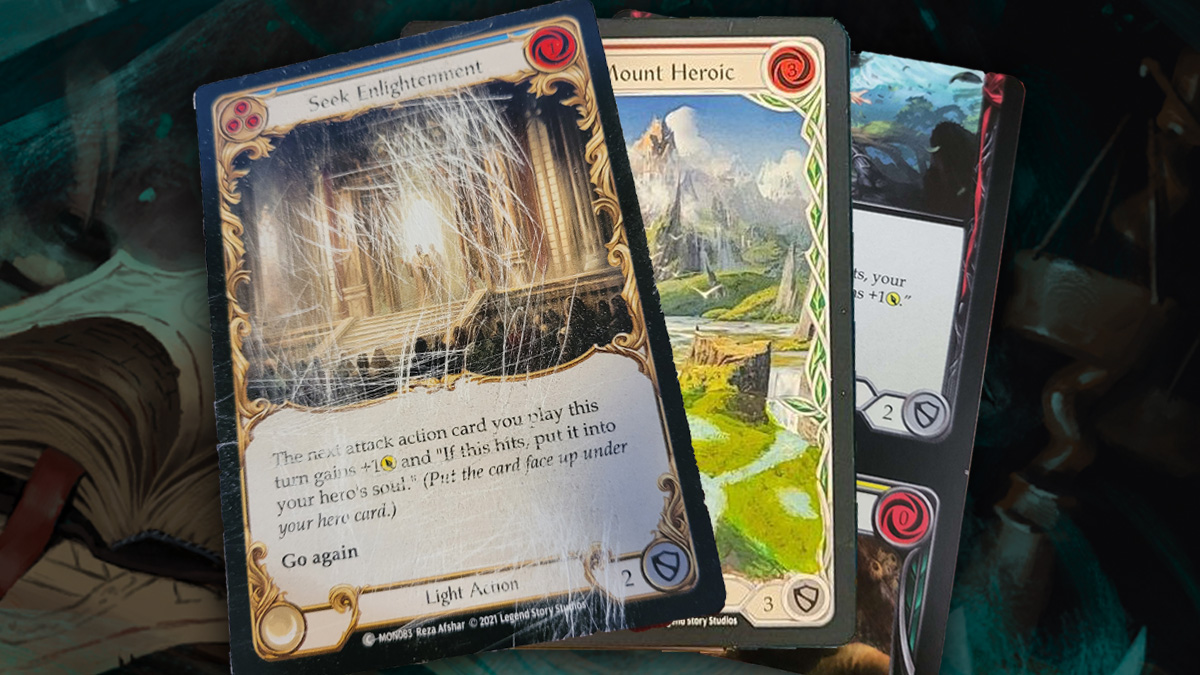
The Unsleevables – Misprints, Alters, and Damaged Cards
June 27, 2023
Yichin Liu is a Level 2 Flesh and Blood Judge from the USA and a member of the blog’s content team. The opinions expressed in this article are his own and do not necessarily reflect those of Legend Story Studios or the Judge Program.
A card is a physical object that represents itself in the game of Flesh and Blood.
Players may use any official card in a tournament. A card is an official Flesh and Blood card if it:
- Is genuine and published by LSS.
- Has a standard Flesh and Blood back-face, has a full-art back-face, is a double-faced card, or is a double-sided token-rarity card.
- Is not a token.
The above quote is the definition of a Flesh & Blood card as defined by the Tournament Rules published by LSS. If you’re reading this, I would assume that you would be able to pick out what a typical Flesh & Blood card looks like. However, like most physical things, what a “typical Flesh & Blood card” looks like doesn’t really encompass the various types of cards that are legal for physical play. Not only do we have to consider whether or not any given physical card accurately represents the card it is purporting to be, but we also have to consider if the card is marked or not. When playing a card in the main deck, cards should be both accurate when presented, and indistinguishable from the rest of the deck when not presented. What should you do, as a judge or tournament organizer, when these cards appear in an event? What metrics can you use to determine whether they should be legal or not? Over the course of this article, we’ll be going over a variety of metrics you can use to determine whether or not to allow cards like these. Let’s begin!
The definition of the “Marked Cards” penalty is defined in the Procedure and Penalty Guide (PPG) as follows:
The player, by their own action, presents a deck of cards where one or more cards are distinguishable from the others while they are in the deck or are face-down.
Players must ensure that all cards and card sleeves in their deck are in good condition and do not have markings or any other features that make them identifiable while in a deck or while face-down. This includes (but is not limited to) scuff marks, nail indents, bent corners, and the curvature of the card itself.
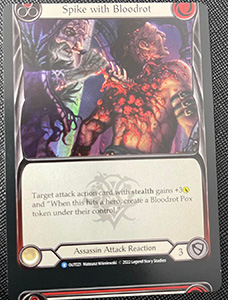


Take a look at the cards above – while they might technically meet the definition of a “legal Flesh and Blood card”, they may have certain qualities that might render them unsuitable for tournament use. As a tournament organizer or judge, you will have the final say as to whether these cards should be allowed for play – but consistency is important for players. If a card is legal as determined by one judge and not legal by another, it can create a negative play experience for everyone involved as players might need to scramble for replacement cards that they weren’t prepared for. First, it might be good to define the types of cases where you’ll need to use your judgment (and LSS guidelines) to determine card legality. These types of cards will fall into three broad categories: misprints, alters, and damaged cards.
Misprints
Misprints are, essentially, cards that were manufactured but the end result is something that is not intended and falls outside the expected margin of error. The last part of that – “falls outside the expected margin of error” – is important. Cards that are slightly off-center or cards that are slightly darker than others, while technically not intended, arewithin an acceptable range of deviation and for all intents and purposes are considered a legal version of the card. Most players understand that a Sink Below that is slightly darker than another Sink Below is still the same card and there’s no confusion about what it is.
The more extreme cases are where it starts getting a little more dubious. Take a look at the following photo – assuming you’re the head judge, would you allow players to play with these cards? Why or why not?

This is a common type of misprint, called a miscut. One of the most common myths about miscuts is the idea that the card’s “actual” identity is the one with the name on the card, and is thus played as the card in question. This is not necessarily the case, though some head judges and/or tournament organizers may rule it one way or another. Guidance from the TRP document states:
A misprinted card is a card that through a design or printing error, does not accurately represent its intended form. A Player may use an otherwise-legal misprinted card provided it is clear what card it represents and the Player is not using it to create an advantage, such as by having misleading text or pictures. If it’s clear what the misprinted card is, but certain printed information on the card is missing or objectively incorrect (such as colour, power, defence etc.), the Player is required to have the correct information available that their opponent can refer to and point it out when the misprinted card becomes visible to the opponent.
When in doubt, use the above guidance, but don’t feel obligated to stick to it when determining card legality. Some other considerations judges take into account when evaluating cards are:
- Is there any ambiguity in what the card portrays? If it has the art of one card and the text of another, the opponent might not be able to tell at a glance what card it is across the table. Even coloration is relevant here; a discolored blue bar may look yellow, leading to possible confusion aboutthe other properties of the card.
- If it is potentially ambiguous what card it represents, is one of those cards illegal to play? If so, that cuts down on ambiguity and reduces the potential advantage of the player with the card. In the above case, it is very unlikely that you would run both Twin Twisters and Murkmire Grapnel in the same deck unless it’s a shapeshifter event.
- Is there a potential for a game state misrepresentation? An action card that looks like an item card will have potential readability issues from across the table.
- What is the rules enforcement level? At the casual rules enforcement level, you can be more permissible as to what’s allowed.
In the specific case of the above Twin Twisters/Murkmire Grapnel, it’s likely that the judge would rule the card to be whatever card is legal in the deck that it’s being played in, as long as the correct card information was readily available. But in a limited environment where this card should be drafted, the duplicate information would likely rule the card and the entire pack to be worthy of replacement. It is entirely possible to assume this is a red Twin Twisters or a yellow Murkmire Grapnel, depending on what part of the card you look at; therefore, to avoid confusion and potential advantage gained by picking it in a draft, it should be removed entirely.
Alters
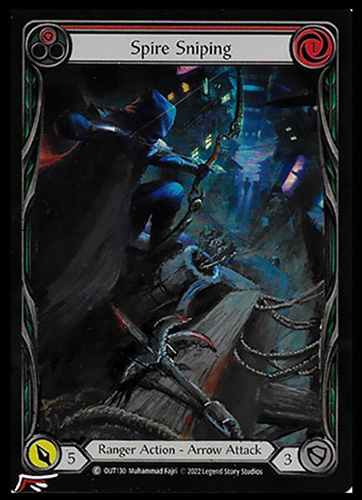
Altered cards are cards that are deliberately changed by someone who is not the manufacturer. These will generally fall into the category of painted alters, though other artistic modifications can use different mediums. The official guidance specifies that altered cards must not cover or obscure the name, pitch, color bar, or cost of the card; in addition, at least one side of the card must be unaltered to validate that it is an official Flesh & Blood card. The official description of an alter is as follows:
An altered card is a card that has been intentionally physically altered, especially for artistic purposes. Alterations include, but are not limited to, painting, foiling, collages, printed inner-sleeves, and anything that intentionally alters the visuals of the card. A Player may use an otherwise-legal altered card provided that any modifications do not cause the card to be unrecognizable, contain offensive material, or give strategic assistance. For the avoidance of doubt, altered cards must originally be official Flesh and Blood cards (not proxies); any artistic modification must not cover or obscure the name, pitch, color bar, or cost of the card; and at least one side of the card must remain unmodified to allow tournament officials to validate its authenticity.
As Flesh & Blood grows, so too will the demand for altered cards grow – it’s only natural that players will want to express themselves and their deck with various custom alters. When evaluating alters, important attention should be paid to the following categories:
- Readability. Can I understand what this card is at a glance from across the table? The more parts of the card that are changed from the standard card, the harder this gets. Art that looks like another card’s art might also be an issue here.
- Noticeability. Does the card look or feel different than a regular card? Some alters can have heavy paint or additional layers of material that might change how it looks and feels when played in a deck, potentially giving players an advantage.
- Sensibility. Is the subject matter depicted in the art acceptable for the standards of the tournament the player is playing in? Flesh & Blood tournaments should be acceptable for all ages, races, genders, and creeds. If you think the alter would make someone uncomfortable or unwelcome, it would be best to tell the player with the alter to use an alternative.
One thing to note is that many alter will be that of heroes, weapons, and equipment. Since these are not maindeckable cards, you can be a bit more lenient when it comes to evaluating whether or not they can be used – but keep the above principles in mind.
Damaged Cards
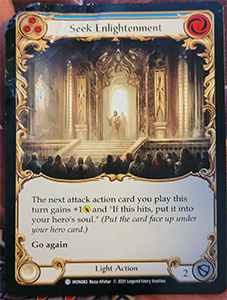
The most contentious and cringe-inducing category would be damaged cards. While most players today employ single-sleeving or double-sleeving methods to protect cards from damage, that’s not always the case – especially during limited events.
Generally, it will not be ambiguous what a damaged card is. The main concern with playing damaged cards comes from the potential for the cards to be marked in some fashion – whether it’s through a missing corner that can be seen or felt through sleeves, a general flimsiness, or some warping of the card that can make it identifiable while face down in the deck or in another hidden zone.
As with before, guidance from the TRP document states:
A damaged card is a card that has received physical treatment that ruins its aesthetic quality and/or functionality as a game piece. A Player may use an otherwise-legal damaged card provided that the damage was due to wear and tear or is otherwise accidental, and the damage does not cause the card to be unrecognizable, or give strategic assistance. Intentionally damaged cards, such as cards that have been cut, ripped, or shredded and reconstructed, are not legal. This does not apply to cards that have been intentionally altered, especially for artistic purposes. If a Player opened a damaged card from limited product, or their card was damaged by an opponent or tournament official, the Player may be issued a proxy.
Warped foil cards, especially warped rainbow foils, can also fall under this category. Due to common warping issues, some foils may become too warped and stand out from the rest of the deck, becoming marked. When checking a deck with foils, it’s important to view a card’s acceptability holistically. Finding replacements is usually a difficult task, especially when it comes to cards that are available in foil-only. Note that guidance from the TRP states that proxies may be issued under the following conditions:
- A foil card where the foiling is the cause of it being marked in the deck, and there is no non-foil version of the card or it would be unreasonable to expect the Player to find a substitute.
- A damaged card where the damage is the cause of it being marked in the deck, and the card was opened from limited product damaged or the damage was caused by the Player’s opponent or a tournament official.
One important caveat of this policy is that we want to be selective when issuing a proxy – it should be a last resort rather than a quick fix. The more lenient you are with issuing proxies, the more you will have to end up issuing during a tournament – and the more lax your players will get when it comes to ensuring their decks! Never let a player rely on you to “fix” their marked deck for them. It is ultimately a player’s responsibility to ensure that their deck is fully legal and passes all checks.
So What's the Verdict?
Hopefully these metrics provided can be of some benefit for you in the field, but it would be ludicrous to assume that they’d cover every use case. There are other types of misprints that may cause similar issues, if not necessarily as severe. So, where do we draw the line? That’s where you come in! We’ve set up a poll similar to the one in this article. Test yourself and evaluate a few examples of misprinted, altered, and damaged cards to let us know what you think should and shouldn’t be allowed. Be sure to read the instructions carefully for context!
